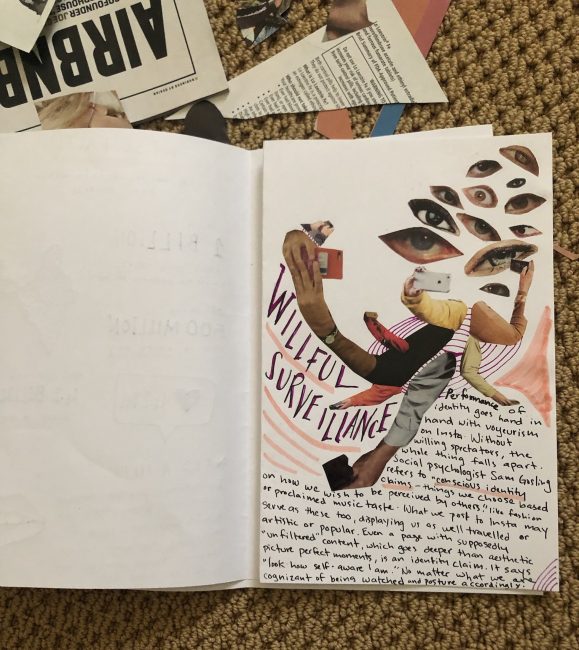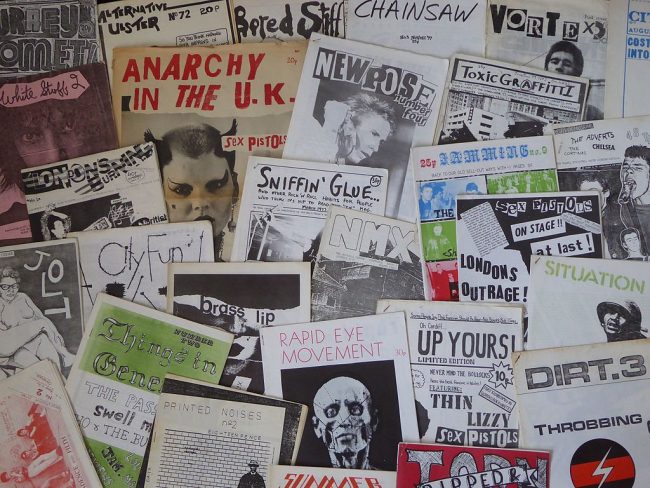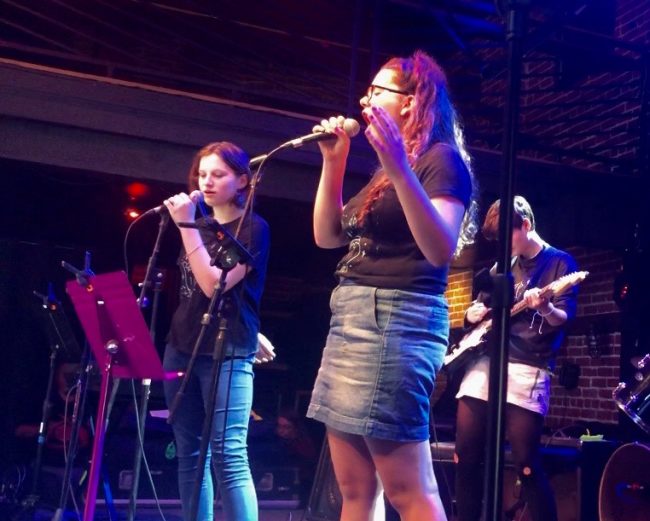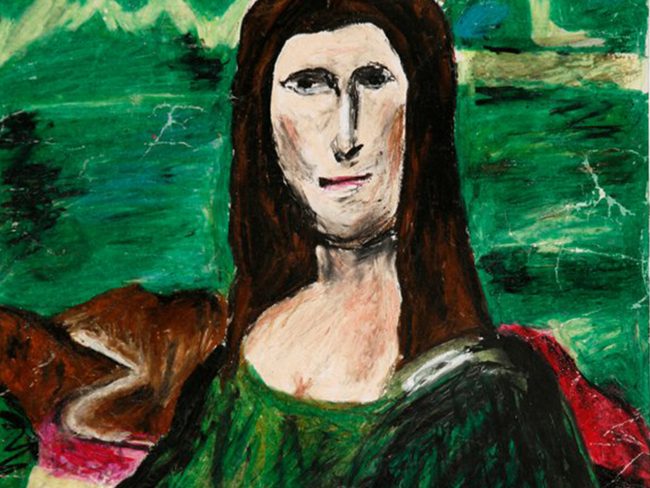Aesthetic Elitism as Symbolic Violence
Posted on October 17, 2019This summer I made a pretty ugly zine. It took me about three full days of turning my bedroom into a total disaster zone of rejected collage cutouts, crumpled-up paper, and ink stains.

The quick and messy process was, in part, a defiant response to my experience during the earlier part of the year, when I felt crushed under immense pressure. I quit my job in March, a few weeks before I knew for sure whether I got into any of the graduate programs I had applied to. I wanted to deprive myself of the option to remain at a job that I had lost passion for. In the months leading up to my departure, I built up a grand vision of how my free months would go. I would finally unleash my musical creativity. I’d write all the songs that I’d been unable to focus on while holding down a full-time job, perform in the city every week, start collaborations with musicians I admired, and feel – for the first time in a long time – free.
Enter situational irony.
The reality I experienced was the complete opposite. I felt completely immobilized and unmotivated to write or play music. Or rather, the desire to create something was so strong that it rendered me utterly useless. Partly, I psyched myself out with my own insane standards and expectations for my ability to produce a creative work I could call “good enough”. What if, despite all the free time I had, I couldn’t write a single “good” song over the summer? What if the new songs weren’t received with the adulation I seemed to seek from the audience? And worst case scenario – what if the problem had not been that my job held me back from making music, but that I just wasn’t a “good” musician?
My friend asked me at some point during this period of inner turmoil if I wanted to make a zine for the Tiny Tech Zine fair in LA, where she had signed up for a table. I jumped at the opportunity to do something fresh and unrelated to my artform of choice.
I was somewhat familiar with zines, but as I dug into the process and ethos of zine-making, I found that it resonated with me on a deep level. According to The Creative Independent, early twentieth-century science fiction enthusiasts used zines – self-published, photocopied booklets – “as a forum for dialogue, free from corporate editors or publishers.”¹ Later, punks of the 80s and 90s, heralded the format for music fanzines and “as a way of challenging mainstream ideologies.” As such, zines of the past were made quickly and usually by-hand, with mixed media that could include photos, doodles, collages, writing, and honestly, whatever the creator wanted. There were no rules to determine how they were supposed to look or who could make one; more than anything, they were meant as a way of sharing ideas, feelings, passions, and stories. Many of these DIY booklets looked wildly different from a formal, stylized publication one might pick up in a store.

Photo of vintage zines via Wikimedia Commons
Zines have recently become quite en-vogue and some have gotten significantly more high-fidelity, but the origins of the medium stick with me. Making my scrappy, handmade zine and distributing it at a fair overflowing with refined, digitally designed publications was a liberating experience. It even got me back into the spirit of making music for fun and self-expression, instead of some arbitrary aesthetic benchmark with which I conflated my success.
That brings me to the central point of this long-winded anecdote: I truly believe we need more “bad” art. In other words, we need more people to make and circulate art (of various forms and media) that is deemed not “good enough” by the powers that be. While this is a battle cry echoed by many anti-establishment art movements throughout history, from Dada to Soundcloud Rap, I am further interested in unpacking some of the internalized beliefs and perceptions that underlie aesthetic elitism, present in both creators (of various forms and media) and those who witness their creations.
As feminist scholar Donna Haraway says, “it matters which ideas we think other ideas with.”[4] My aim is not to suggest that art creation is effortless – I certainly don’t believe that – nor to have a whole discussion around what art is in the first place. Rather, I want to pose a few questions: What silently shapes our beliefs about the value and purpose of art? What determines the quality of an artistic creation? What other ideas did these metrics for judgment come from? Who gets to be called an artist these days and who does the calling?
A Lot of -isms (But Mostly Capitalism)
We all make our way through the world with certain frameworks in place about how things are and ought to be. In large part, these frameworks are learned implicitly over time, through personal experience, observation, culture, and interactions with other beings or objects.[5] Some frameworks we’ve internalized are part of what designers Joanna Boehnert and Dimeji Onafuwa call “the oppressive ‘-isms’ (sexism, racism, classism, colonialism, imperialism, etc.) which are reproduced by institutions and cultural practices and artifacts in everyday life.”[6] They analyze design as a tool that may reproduce these -isms and describe it as an example of what French Sociologist Pierre Bourdieu defines as “symbolic violence.” Most poignantly, they write that “through symbolic violence, individuals learn to consider unjust conditions as natural and even come to value customs and ideas that are oppressive.”[6] Symbolic Violence is a powerful term to have in mind in the context of discussing aesthetic elitism.
An unmentioned but relevant -ism in Boehnert and Onafuwa’s discussion is capitalism – by Lexico’s definition, “an economic and political system in which a country’s trade and industry are controlled by private owners for profit, rather than by the state.”[7] Living as part of a capitalist system, I (and maybe you, too) have internalized certain beliefs that are based on oppressive ideologies. For example, the music world operates through a capitalist worldview, reinforced by questions that musicians ask other musicians like, “Do you do music full time or do you have a day job?”, “Do you live off playing music?”, or “How much do you make from that gig?” These questions are sometimes asked to size people up and place them within the dominant framework of a “successful musician.” It’s as if what determines your legitimacy as an artist is your ability to generate wealth through your art. In Haraway’s terms, we use capitalist ideas to think about our ideas of art.[4]
This informs judgments of aesthetic appeal and creates internalized perfectionism. What’s worthy of sharing with the public? Personally, I would hesitate to post a recording of me performing without my guitar plugged in and in which my vocals sound too muffled to hear. Why? Well, it’s not the best representation of what I’m trying to convey. But on some level, because I believe that if it doesn’t reach a bare-minimum standard that people expect from a musical recording nowadays, they wouldn’t listen to it. Of course, to get it to sound fully ‘professional,’ I’d have to rent out studio space and get an engineer, and someone to mix and master the song, and so on – which requires a lot of money that I don’t have. This is a reductive and basic example rooted in technical quality, which is not always important, but it’s easy to see how this can compound into an insidious perfectionism that creates increasingly higher standards of aesthetic requirements, and ultimately discourages a creator from creating.
It also illuminates a danger of art being seen as capital: aesthetic finesse or the dominant aesthetic preferences of an era are valued over the expression of ideas and emotions. The reason a certain “sound” is expected is because major labels have favored them and to a large extent, they still control the industry. And why wouldn’t we instinctively abide by their rules, subliminally disseminated across airwaves through mainstream music? As Boehnert and Onafuwa write, “it is through processes of symbolic violence that power imbalances are naturalised.”[6] It’s fortunate that this hegemony is starting to crumble, as artists take matters into their own hands.
Another side of this goes beyond the symbolic violence that shapes internal beliefs or taste and relates to access. Being an artist of any kind is expensive and subject to standards of aesthetics determined by the powerful. Who can afford to be an artist in a capitalist system, in which inequality is dramatic and people struggle to stay afloat? And as a result of such constraints, whose voices are most often amplified in mainstream arts scenes? Gregory Sholette, author of “Delirium and Resistance: Activist Art and the Crisis of Capitalism” contrasts the way “high art” is touted as having moral significance against its reproduction of existing power structures.
“Attempts by elites, as much as well-intentioned romantics, to paint high art as an evocation of humanity’s mysterious depths must come to terms with the realities of a…56 billion dollar art market in a globally dispersed field where there are more artists, and more artworks being produced, than perhaps ever before in history. And yet, much as things are with the neoliberal economy in general, this art world concentrates value amongst a small number of champions, leaving the majority to serve as its system of barely recognised reproduction and maintenance.” [8]
Ch-ch-ch-ch-changes (In Our Values)
Evidently, the symbolic violence of art as capital pervades both our psychology and our society and creates elitism in our judgments of art as consumers as well as fellow creators. How might we change the narrative of what constitutes valuable art? And how might we encourage people to overcome the feeling that expression through art needs to look or sound a certain way in order to be shared? In order to be appreciated? In order to be engaged with?
A big source of hope for me is young people. And I understand it might be slightly laughable for a 24 year old to make that statement. But kids are so cool; they have unique voices and so much to say. Yet, often, their feelings and expressions are dismissed as immature, unimportant, or lacking in depth. This perpetual silencing is a form of symbolic violence unto itself, because it reproduces larger structures that disempower youth, especially women and gender-nonconforming people.
Time for one last story from my summer.
In the midst of feeling quite lost and sad, I decided I’d volunteer at Bay Area Girls Rock Camp while I was visiting my parents. The program, which is specifically for female, trans, and non-binary youth, brings in campers from around the Bay Area, puts them in a band of others they’ve never met before, asks them to write a song together, and perform it – all over the course of 5 days. Many of the campers had never even played their chosen instrument before. By the end of the week, the bands had written complete songs with lyrics, and played them in front of a pretty sizeable crowd at a venue in Oakland.
A unique aspect of the program is the instrument instruction philosophy, which is unlike any I’ve experienced in my 15+ years of learning music of various genres. As instructors, we were not to correct any technical mistakes we witnessed or give advice about the campers’ songs, unless we were specifically asked to. It was tough to embody this in practice, when a camper would be wildly out of key while playing a chord progression, but having a grand old time in the experience of connecting with her bandmates. I had to literally sit on my hands at times and fight my instinct to “fix it.”

A bunch of rockstars
The songs that emerged were incredible, but not in the conventional ways in which we’ve come to judge musical aesthetics. One camper, who always looked sullen in guitar class, and barely said two words all week, wrote the lyrics to her band’s song, describing her difficulty trusting people and letting them in. Another camper, whose band created a 4-part conceptual piece about mood swings, let out a guttural scream into her microphone at one point in the song. The joy was literally radiating off her cheeks. During the course of the week, the campers also had workshops in power dynamics and privilege, screen printing, and zine-making. All this coalesced to create a space where a typically de-valued, silenced population really shared what was on their minds, through different forms of art and communication, and made sense of their worlds together. That takes guts beyond what a lot of people can muster.
One of the staff members of BAGRC mentioned to me that when they do pitches to get funding for their organization, many potential supporters have adverse reactions to the songs. “This is bad. Why don’t you teach them to be better at music?” The question is pretty illustrative of several oppressive -isms embedded in our culture. They’re hard to beat, and sometimes creep up even within well-meaning interactions.
I’m trying hard to alter my own frameworks of operating in the world as a creator and as someone who appreciates the arts. I want to unlearn elements of internalized aesthetic elitism and embrace the process of creation along with the vulnerability of sharing something you’ve created with someone.
– A. Nair
References: [1] Rona Akbari, “How to Make a Zine,” The Creative Independent (Kickstarter, November 2018), https://thecreativeindependent.com/guides/how-to-make-a-zine/. [2] Karen Kedmey, “100 Years On, Why Dada Still Matters,” Artsy, May 25, 2016, https://www.artsy.net/article/artsy-editorial-100-years-on-why-dada-still-matters. [3] Matt Teffer, “SoundCloud Rappers: This Is Who Your Teens Are Listening To,” Australian Financial Review, August 31, 2018, https://www.afr.com/life-and-luxury/arts-and-culture/soundcloud-rappers-this-is-who-your-teens-are-listening-to-20180809-h13r3p. [4] Donna Jeanne Haraway, Staying with the Trouble: Making Kin in the Chthulucene (Durham: Duke University Press, 2016). [5] Erving Goffman, Frame Analysis (Boston: Northeastern University Press, 1986). [6] Joanna Boehnert, and Dimeji Onafuwa. 2016. "Design as Symbolic Violence: Reproducing the ‘isms’ + A Framework for Allies " Paper presented at Intersectional Perspectives on Design, Politics and Power, School of Arts and Communication, Malmö University, November 14-15, 2016. http://www.decolonisingdesign.com/wp-content/uploads/2017/06/Boehnert_Onafuwa_Design-as-Symbolic-Violence.pdf [7] “Capitalism: Definition of Capitalism by Lexico,” Lexico Dictionaries | English (Lexico Dictionaries), accessed October 17, 2019, https://www.lexico.com/en/definition/capitalism. [8] Gregory Sholette, “Untangling Art's Relationship with Capitalism,” Pluto Press, October 16, 2017, https://www.plutobooks.com/blog/art-and-capitalism/.
